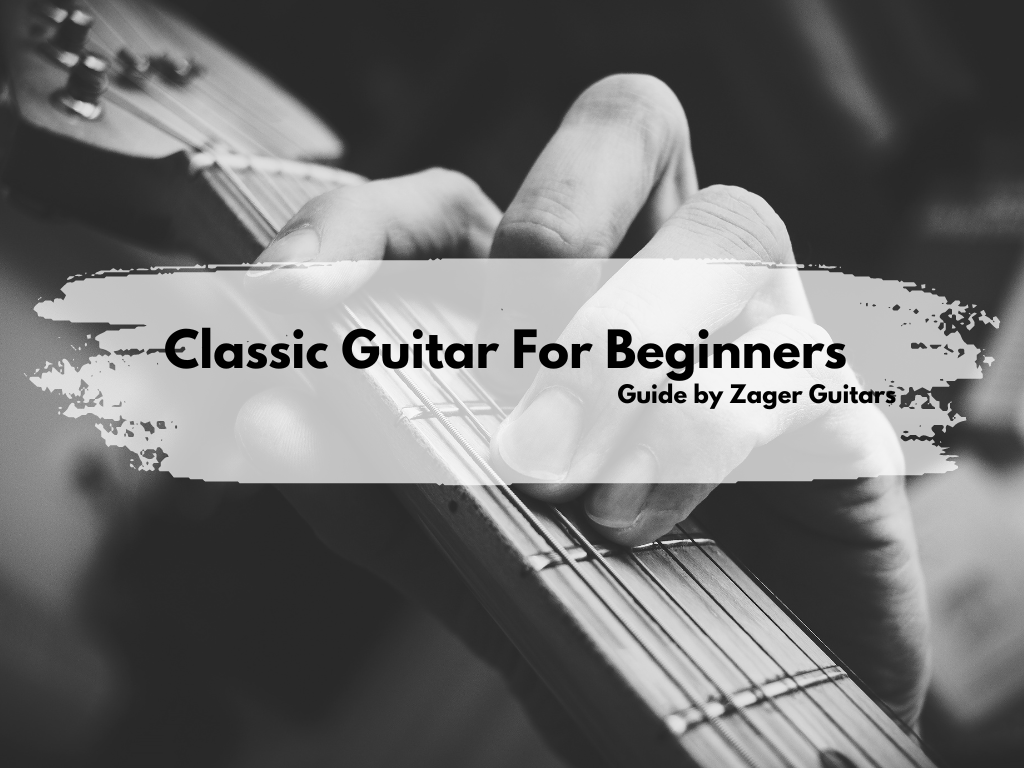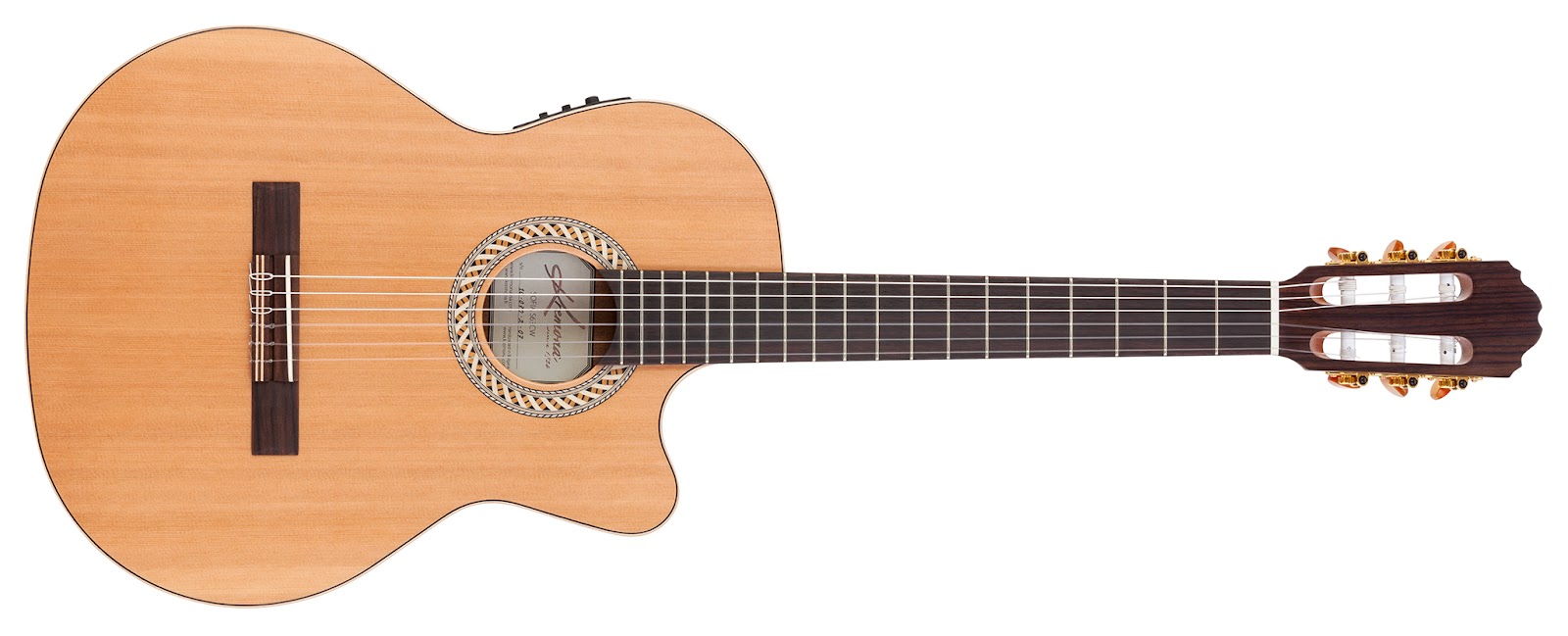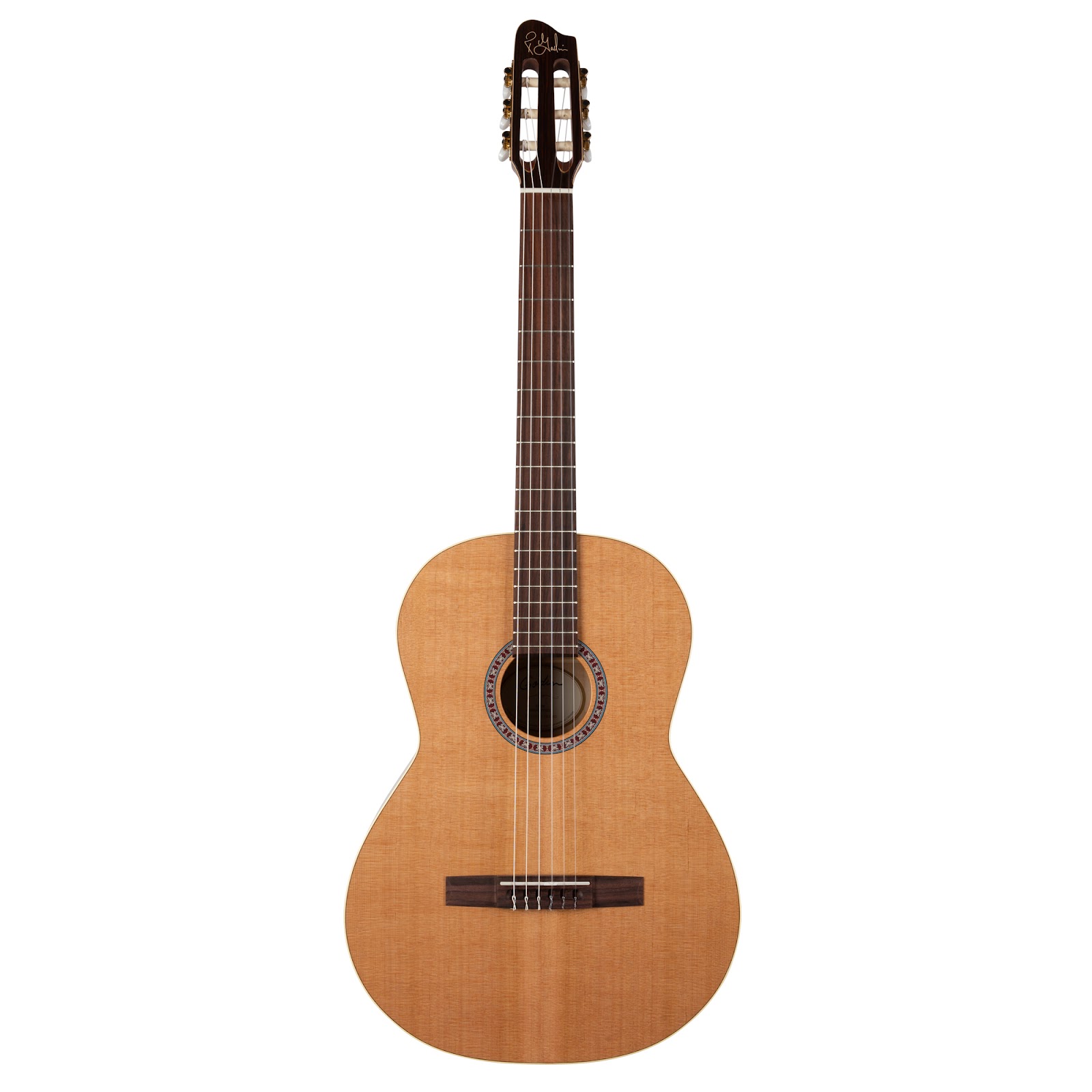Classic Guitar For Beginners – A Guide by Zager Guitars

When it comes to choosing the best beginner classical guitar, there are plenty of options available. Choosing an affordable, easy-to-play, and good-sound guitar is important for a beginner. Here are a few top picks to get you on the right track.
Zager ZAD80CE

ZAD80CE features a solid spruce top with hand-selected quartersawn scalloped bracing, which provides a rich, balanced tone with plenty of projection. The back and sides are made of solid Indian rosewood, which enhances the guitar’s bass response and sustains it.
It is a high-quality guitar that’s perfect for players who want a versatile instrument with great tone and playability. Whether you’re a beginner or a seasoned player, the ZAD80CE is a great choice for anyone looking for a high-quality acoustic-electric guitar.
Price $2195
Yamaha C40II
cc Yamaha
The Yamaha C40II is an exceptional choice for beginners because of its affordability, durability, and easy playability. It has a spruce top and a meranti back and sides, which gives it a warm and balanced sound.
Price $252.20
Cordoba Mini II Classical

The Cordoba Mini II is a small-sized classical guitar for someone always on the go! It is a perfect guitar for beginners as it features a 1/2 size body with a solid spruce top and a mahogany neck with a rosewood fingerboard.
This guitar also comes with high-quality Aquila nylon strings and a Cordoba gig bag for easy transport. It makes a perfect choice for someone who loves jamming and wants a high-quality portable guitar.
Price $149.00
Kremona Sofia S63CW

cc Kremona
This guitar is a step up in price, but its quality justifies the investment. It has a solid cedar top, rosewood back and sides, and a mahogany neck. Its rich sound and comfortable playability makes it an excellent choice for beginners who want a more premium instrument.
Price $999.00
Fender CN-60S

cc Fender
The Fender CN-60S is a great choice for those looking for a quality nylon-string guitar at an affordable price. Its solid construction, playability, and electronics make it suitable for beginners, intermediate players, and even professionals on a budget.
It has a Fishman Isys III pickup system allowing easy amplification and use. The system also includes a built tuner volume and tone control and a battery indicator light.
Price $199.99
La Patrie Etude

The La Patrie Etude is another handcrafted classical guitar perfect for beginners. It has a solid cedar top and wild cherry back and sides, which give it a warm and mellow sound. Its easy playability and beautiful craftsmanship make it a great investment for anyone starting on the classical guitar.
Price $299.99-1409.5
Epiphone PRO-1 Classic

cc Epiphone
The Epiphone Pro 1 Classic is an excellent choice for beginners looking for an easy-to-play guitar with nylon strings, solid construction, and quality components. Its comfortable neck profile and jumbo frets make it an excellent option for players with smaller hands or those who struggle with traditional classical guitar necks.
The guitar also comes with Epiphone’s JumboPRO frets, which are larger than standard frets and make it easier to play notes accurately.
Price $129.00
Takamine GC1CE

cc Takamine
The GC1CE offers a fan-braced select spruce top and mahogany back and sides for a complete and balanced sound, making it a great option for any performer looking for an economical acoustic-electric classical guitar that performs well above its price tag.
The onboard Takamine TP-E preamp system features a built-in tuner, volume and tone controls, a mid-cut switch, and a comfortable mahogany neck with a laurel fingerboard for exceptional feel and playability.
A dovetail neck joint, stunning mosaic inlaid rosette, synthetic bone nut and saddle, laurel head cap, chrome tuners with white pearl buttons, and a classy gloss finish are just a few of the amazing qualities this guitar has to offer.
Price $419.99
Ibanez AEG50N

The Ibanez AEG50N is an acoustic-electric nylon-string guitar designed for players who want a high-quality instrument in various musical settings. It features a solid spruce top, a Sapele back and sides, a nato neck, and a rosewood fingerboard. The guitar has a cutaway design, making it easier to access the higher frets.
Price $329.99
Yamaha CG122MSH

Cc Amazon
The Yamaha CG122MSH is one of the best beginner classical guitars with nylon strings. Although it may appear to be a typical guitar, the tone, construction quality, and playability are worlds apart.
The full 2-inch nut width provides the authentic traditional playing experience, and the solid Engelmann spruce top gives the tone a depth and richness that sounds great. This classical guitar for beginners has a lot of appealing qualities.
Price $249.99
Reasons to Invest In a Classical Guitar
Are you ready to fall in love with the beautiful sounds of a classical guitar? Let me tell you why owning one is necessary for any music lover!
First and foremost, classical guitars are perfect for playing classical music. Their unique sound is ideal for playing the intricate and delicate pieces of the classical guitar repertoire. And let’s be honest; there’s nothing quite like the sound of a well-played classical guitar piece to transport you to another time and place.
But classical guitars are not just limited to classical music. They are also incredibly versatile instruments, tackling various genres, including flamenco, folk, and even some rock music. With a classical guitar in your arsenal, you’ll have the freedom to experiment and explore different styles of music.
Classical guitars are an excellent choice for those just starting their musical journey. Their wider necks and softer strings make them easier to play than other types of guitars, which means you’ll be able to get started on your musical journey with less frustration and more enjoyment.
And the best part? Classical guitars are relatively affordable compared to other types of guitars. So whether you’re a beginner or a seasoned player, owning a classical guitar won’t break the bank.
Why Should You Avoid Investing In a Classical Guitar?
While classical guitars are beloved by many, they may not be the perfect instrument for everyone. Let’s explore why you might want to avoid investing in a classical guitar.
First and foremost, classical guitars are primarily designed for playing classical music. While they can be used to play other genres, such as flamenco or folk music, their versatility is somewhat limited compared to other guitars. If you want to explore a more comprehensive range of musical styles, a different kind of guitar may be better for you.
Classical guitar playing also requires a high level of skill and technique. If you’re starting your musical journey, you may find that a more straightforward instrument, such as an acoustic guitar, better fits your skill level.
While classical guitars can be affordable, many high-end models are expensive. If you’re on a tight budget, investing in a classical guitar may not be the best use of your funds.
Maintenance is also a consideration. Classical guitars use nylon strings, which require more frequent maintenance than steel strings. If you’re not prepared to spend time and money on string maintenance, a different type of guitar may be better for you.
Although classical guitars have a beautiful and distinct sound, it may not be everyone’s cup of tea. If you prefer a brighter sound or the distortion of an electric guitar, a classical guitar may not be the best fit for you.
Playing Classical Guitar In Free Stroke Or Rest Stroke
Playing classical guitar is a beautiful art form that requires discipline, practice, and a solid understanding of various techniques. Among these techniques, free and rest strokes are the most important and rewarding to learn.
Free Stroke
Unrestricted stroke involves plucking a string with your fingertip and allowing it to rebound freely. This technique produces a soft, mellow sound that creates a relaxing ambiance. To play a note with unrestricted stroke, you’ll need to position your fingertips just above the string and then use the tip of your designated finger to pluck the line in a downward motion. After plucking the line, let your finger bounce away from the line naturally.
Rest Stroke
Rest stroke, on the other hand, involves plucking a string and then bringing your finger to rest on the adjacent line. This technique produces a louder, resonant sound that is perfect for creating dramatic and powerful melodies.
To play a note with a rest stroke, position your fingertip over the desired string and pluck the line downward. After plucking the string, allow your finger to rest on the adjacent line.
Mastering these techniques takes time and practice, but the results are worth it. As you become more comfortable with unrestricted stroke and rest stroke, you’ll start to hear the nuances and subtleties of each technique, allowing you to create music that is uniquely your own.
What are the Differences Between a Classical and Acoustic Guitar?
Classical and acoustic guitars are popular instruments with distinct construction, playing techniques, and sound differences. Here are some of the main differences between the two:
Construction
Classical guitars typically have a smaller body and a narrower neck than acoustic guitars. They also have nylon strings, whereas acoustic guitars have steel strings. The bracing inside the guitar is also different, with classical guitars having fan bracing and acoustic guitars using X-bracing.
Playing Technique
Classical guitars are played with fingerpicking technique, whereas acoustic guitars can be played with a pick or fingers. Classical guitar playing often involves intricate fingerpicking patterns and classical music repertoire, while acoustic guitars are commonly used in popular music, rock, and folk.
Sound
The sound of a classical guitar is typically softer, warmer, and more mellow than an acoustic guitar. The nylon strings produce a less bright sound than steel strings, which can be more piercing and twangy.
Style
Classical guitars are often associated with classical music and flamenco, while acoustic guitars are more commonly used in popular music, rock, and country music.
Overall, classical and acoustic guitars have unique characteristics, and choosing between them depends on your musical interests and playing style.
Can You Use a Classical Guitar as an Acoustic?
Have you ever wondered if you can play your classical guitar as an acoustic one? Well, the answer is yes! There are some things you should consider before you start strumming away.
Classical guitars are typically designed to play with nylon strings, producing a softer, warmer tone compared to the bright and twangy sound of steel strings on acoustic guitars. So, if you’re considering using your classical guitar as a hearing, stick with nylon strings.
Additonally you should keep in mind the neck size of the guitar. Classical guitars have a wider neck than most acoustic guitars, making playing certain chords and fingerpicking patterns more challenging. However, some guitarists prefer the broader channel as it can provide more space for fingerstyle playing. So, depending on your playstyle, you might need to adjust your technique to accommodate the different neck styles.
One more thing to keep in mind is the sound of the guitar. The tone of a classical guitar is warm and mellow, while the acoustic guitar is known for its bright and punchiness, so if you’re looking for a classic acoustic sound, it might be better to invest in an acoustic guitar with steel strings.
While you use an acoustic guitar or classical guitar, it’s essential to remember the differences in string type, neck size, and sound. So, if you’re up for the challenge, give it a go yourself!
What Is The Best Way To Learn Classical Guitar?
Have you ever listened to classical guitar music and wished you played like that? The good news is that you can! Learning classical guitar is a gratifying experience that can prove to be a source of lifetime enjoyment, and many resources are available to help you offline and online!
One of the best ways to learn how to play classical guitar is by getting classical guitar lessons from an instructor who can guide you through the learning process. However, if you cannot find a tutor, you can learn it at your own pace with the other resources available online.
To begin with, the Zager Lesson Library offers comprehensive guitar lessons that can help you master classical guitar and other styles of music. With video tutorials, sheet music, and practice exercises, the Zager Lesson Library provides everything you need to become a skilled musician!
Why should I Buy a Classical Guitar?
Whether you’re a fan of classical music or prefer more contemporary styles, the classical guitar has something to offer.
And let’s not forget about the portability factor! Unlike larger instruments, the classical guitar is easily transported, allowing you to take your music wherever you go. So whether you’re sitting in your backyard, hanging out with friends, or traveling to a new destination, your guitar can be right by your side.
And the best part? You don’t need to break the bank to get started. Plenty of high-quality classical guitars are available at a range of price points, so you can find one that fits your budget.
About Us
Zager Guitars is a family-owned third-generation guitar builder building guitars in Lincoln, Nebraska, since 1902. It has been rated in the top 5% of all guitar brands. It has been featured in Time Magazine, Newsweek, The Wall Street Journal, Forbes, Rolling Stone, The New Yorker, ABC, NBC, CBS, CNN, FOX, and many national and international news media.
Many players have tried our guitars over the last 50 years because of muscle and joint pain, MS, arthritis, nerve damage, fibromyalgia, carpel tunnel, shoulder and back pain, broken fingers, and missing fingers. Our string heights are lower, allowing you to come down on the strings from a more perpendicular angle, so you no longer have to reach over other strings muting them out.
One thing that’s very different about our guitars is the spacing between the strings side to side is slightly wider, which creates more room for your fingers, so when you’re forming chords, you’re not accidentally leaning on strings that you don’t want, creating buzzes and rattles.
FAQs
Is Classical Guitar Good For a Beginner?
Choosing a classical guitar to improve your playing technique would be best. Classic models feature nylon cords perfect for fingertips which is good for beginners!
What Should I Learn First On Classical Guitar?
Arpeggios (fingerpick) Scales (alternating hands) Training (to develop strength)
Which Classical Guitar Is The Easiest To Play?
Yamaha Classic Guitar – C40. Prices from $170 to $2000. Cordoba CM 3 Classic Guitar Price – $200 -250 Yamaha C-Series CG122 Classic Guitar. Natural Prices: $100-250. … Cordoba C-5 Classic Guitar Price: $300-3000
Can I Teach Myself Classical Guitar?
Yes, you can through online resources, but it is advised to learn it from a pro!
